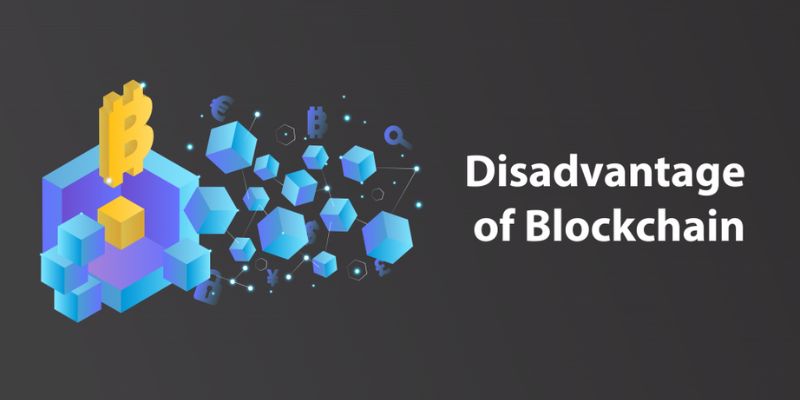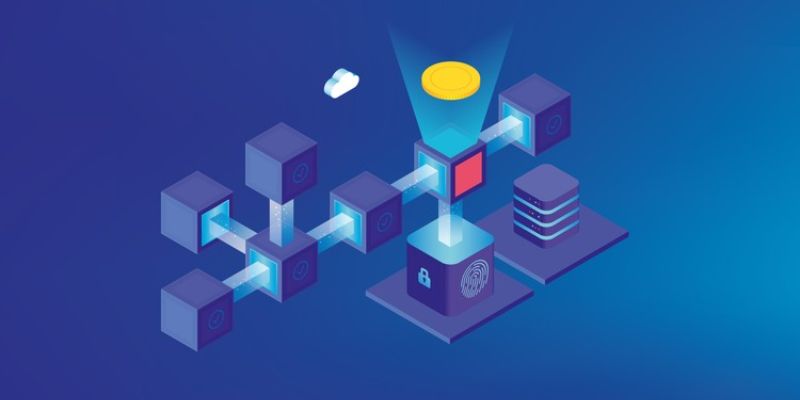Disadvantages of Blockchain Technology: Unveiling the Hidden Downsides
Blockchain buzz often drowns out the downsides. Yet, like any tech, it’s not perfect. Dive deep with me into the disadvantages of blockchain technology. We’ll look at its heavy energy use, safety challenges, tricky tech limits, and its cost and societal effects. Join me to see what’s behind the hype.
The Energy Dilemma: Environmental Costs of Blockchain
Energy Consumption of Crypto Mining
Crypto mining eats up a lot of power. Why? It needs strong computers that solve hard math puzzles to get new coins. These puzzles get tougher over time, making miners use more power. Miners race to solve puzzles first, pushing energy use up. This race means they’re always on, burning power non-stop.
Now, let’s dive in. Mining one Bitcoin can use as much power as a house does in two months. Crypto mining tends to seek out cheap power, which can lead to using dirty energy sources like coal. This reliance on fossil fuels turns crypto mining into a heavy polluter. Much of the energy used comes from grids that could otherwise support entire communities.
Cryptocurrency Environmental Impact
Cryptocurrencies don’t just zap power; they can hurt our planet too. When miners use cheap but dirty power, they add to air pollution and greenhouse gas emissions. This can change our weather and harm wildlife. The puzzle races result in a massive carbon footprint for cryptocurrencies.
Every time we trade or mine coins, we’re putting more strain on the environment. More miners mean more power use and more emissions. As cryptocurrencies grow, this worry grows with it. We need to think about how we can develop these technologies in ways that keep our air clean and our planets safe.
While it’s clear that cryptocurrencies offer exciting possibilities, we can’t ignore their environmental toll. To truly embrace crypto, we need to make sure it doesn’t come at the cost of our planet’s health.
Regulatory and Security Challenges in Blockchain Adoption
Lack of Regulation in Blockchain
What does “lack of regulation in blockchain” mean? It means rules are scarce here. No big boss looks over blockchain’s shoulder. This sounds cool, right? Well, not quite. It’s like a playground with no rules. Fun at first, but things can get messy fast.
Without rules, bad folks may try tricks. We need clear laws to keep things fair. Think of it this way: It’s hard to play a game if no one agrees on the rules. Just like that, blockchain needs rules so everyone plays nice.
Some people think blockchain is the wild west—no sheriff in town. This scares some users away. Why put money in a bank with no safe? That’s what using blockchain without rules can feel like. And let’s not start on taxes or legal stuff. It’s a maze, friends.
Blockchain Security Vulnerabilities
What are “blockchain security vulnerabilities”? These are weak spots where hackers can break in. Blockchain is tough, no doubt. But it’s not unbeatable.
One big problem is smart contract flaws. If a smart contract has a bug, a hacker can sneak in. It’s like a house with a hidden back door. And once they’re in, oh boy, they can cause a mess.
Then there’s the risk of blockchain forks. It’s when a blockchain splits in two. Ever watch a road split with no signs? Chaos! That’s forks for you. Some people go one way, others the other way. No one knows who’s got the real deal.
Also, there are attacks called 51% attacks. It’s when someone gets more than half the control of a blockchain. Imagine if one kid had over half the toys in the playground – it wouldn’t be fair play, would it?
We also worry about quantum computing. These super machines might one day crack blockchain’s locks. Think super-powered lockpickers. No lock is safe forever.
Still, we’re on it. We’re beefing up security every day. We tell folks to patch up their systems, use the latest tools, and stay sharp. Like building a higher wall and a deeper moat around our castle. We’ve got treasures to protect here.
So yeah, blockchain’s got some downsides. But we’re working hard to make it sturdier. We dig into the flaws, fix what we can, and keep our eyes wide open for trouble. We learn from every hiccup and bump. We want blockchain to be a safe place for all. Not just a playground, but a real fortress of trust and tech.
Technical Limitations and User Experience Concerns
Blockchain Scalability Issues
Have you heard folks say blockchain tech can’t handle lots of transactions fast? That’s true. Big blockchains often slow down when many people use them all at once. When too many transactions happen, it creates a traffic jam. This means each transaction takes longer. It’s like when you’re in a rush and the internet’s slow. It can make you want to give up and not use it.
Blockchains are trying to fix this, but it’s hard. They want to keep records safe while picking up the pace. Right now, they can’t do both perfectly. Some people try to make new blockchains that are faster, but these aren’t always safe or easy to use with other blockchains. You want your tech to talk nicely with other tech, right?
Blockchain Complexity for Users
Now, let’s chat about how tricky it is for people to use blockchains. You might think tech should make life easier, right? But here’s the rub: blockchains can be super complex to understand. There’s all this talk about “private keys” and “wallets.” It’s enough to make your head spin! Plus, if you lose your private key, it’s like losing the key to a treasure chest. No one can get it back for you.
And there’s more. Smart contracts are like robot deals that run on blockchains, but if they have a tiny mistake, they might do something you never wanted. Imagine you’re playing a video game and there’s a glitch that wipes out all your progress. That’s how it can feel.
Blockchains could someday help us do things like vote or track stuff we buy. But they’ve got to be easier for everyone to use first. You don’t want to take a class just to use your phone, do you? It should be no different with blockchains. They need to be as simple as using an app to order a pizza.
To sum it up, blockchains have a ways to go. They are works in progress. They could be really helpful, but only if we can make them fast enough to handle our busy lives and easy enough for anyone to use. They’re cool, no doubt—but they’ve got to work in the real world.
Economic and Societal Implications of Blockchain
Decentralization and Governance Issues
Many people think blockchain’s like voting without a boss. But sometimes, no boss makes rules hard to agree on. Workers and leaders may clash. Without clear rules, who decides when we disagree?
Blockchain needs leaders too. But they don’t always have the power to call the shots like in a company. This means when big decisions come up, blockchain communities can split on what to do. These splits are called forks. They can cause confusion and even break trust in the system.
Let’s look closer at these forks. Imagine everyone keeping an eye on a giant book of records, and suddenly there are two books. People must choose which one to trust. A fork happens. With forks, your blockchain money or votes could be in danger if people can’t decide which book is right.
Blockchain Cost Implications
Talking about costs, blockchain isn’t always cheap. Each person that uses blockchain needs strong, costly computers. They use these to be part of the network and make sure everything’s fair.
Setting up can cost a lot. Small groups or folks just starting might find this too pricey. Did you know that keeping the blockchain running takes a lot of power too? Each time someone checks or adds something, it eats energy like a hungry monster.
We hear that crypto money doesn’t hurt the air, but that’s not the whole story. The energy to run blockchain comes from big power plants. Some of these plants burn coal or gas, which can make the air dirty. This brings us to a big worry: our planet’s health.
So let’s imagine you’ve got your own lemonade stand. Now think if running this stand every day took more power than your whole street’s lights. Seems too much, right? That’s what it’s like with some blockchains.
But it’s not all doom and gloom. Remember, every problem is there to be fixed. We can work on making blockchains that eat less energy. And guess what? Some smart people are already on it, creating new ways to do the same blockchain magic but with less power. It’s like figuring out how to run your lemonade stand with just a tiny solar panel.
Even with these problems, blockchain still gives us some cool things. Things like owning digital stuff no one can take from you, or sending money across the world fast without a bank. But as we enjoy these new treats, let’s not forget to think about our planet and how we run our digital lives together.
In the end, it’s about balance. We want the goodies that blockchain brings, but we have to think about costs. Not just the cash but the power it uses and the way we all decide what’s fair. When we work on a problem, it’s like a puzzle. And solving puzzles can be a lot of fun. Let’s keep our brains and hearts in the game to make blockchain work better for everyone.
In this post, we dug into the tough parts of blockchain technology. We saw how crypto mining eats up a lot of power and hurts our planet. We also touched on the rules missing in blockchain and how it could be risky without them. Then, we talked about how blockchain scales and why it’s hard for everyday folks to use. Lastly, we looked at how it shakes up who’s in charge and costs.
For me, the key takeaway is balance. Yes, blockchain has cool benefits, but it’s not perfect. We have to fix its energy use, make it safer, and easier to handle. Also, we need to figure out who’s running the show and how much we pay for it. As an expert, I believe we can work out these kinks. If we get it right, blockchain could really change our world for the better.


